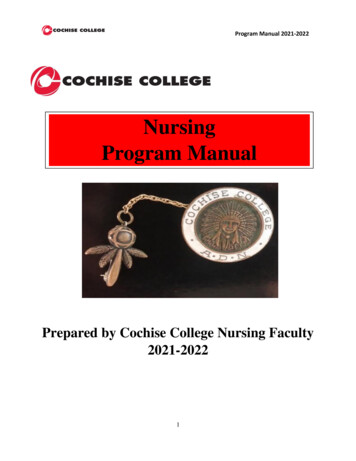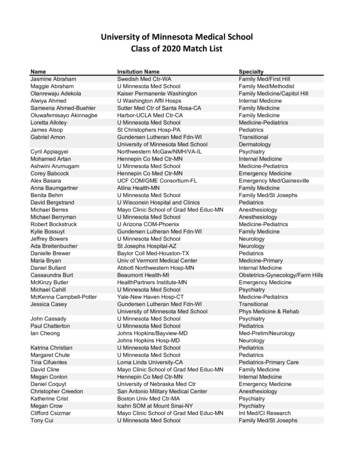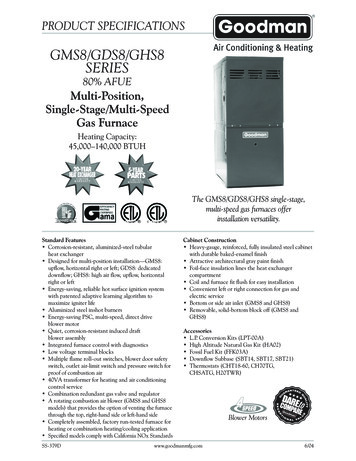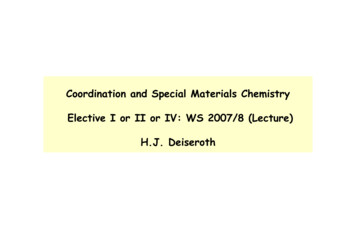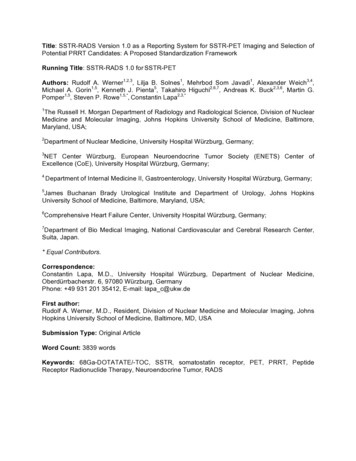
Transcription
Title: SSTR-RADS Version 1.0 as a Reporting System for SSTR-PET Imaging and Selection ofPotential PRRT Candidates: A Proposed Standardization FrameworkRunning Title: SSTR-RADS 1.0 for SSTR-PETAuthors: Rudolf A. Werner1,2,3, Lilja B. Solnes1, Mehrbod Som Javadi1, Alexander Weich3,4,Michael A. Gorin1,5, Kenneth J. Pienta5, Takahiro Higuchi2,6,7, Andreas K. Buck2,3,6, Martin G.Pomper1,5, Steven P. Rowe1,5,*, Constantin Lapa2,3,*1The Russell H. Morgan Department of Radiology and Radiological Science, Division of NuclearMedicine and Molecular Imaging, Johns Hopkins University School of Medicine, Baltimore,Maryland, USA;2Department of Nuclear Medicine, University Hospital Würzburg, Germany;3NET Center Würzburg, European Neuroendocrine Tumor Society (ENETS) Center ofExcellence (CoE), University Hospital Würzburg, Germany;4Department of Internal Medicine II, Gastroenterology, University Hospital Würzburg, Germany;5James Buchanan Brady Urological Institute and Department of Urology, Johns HopkinsUniversity School of Medicine, Baltimore, Maryland, USA;6Comprehensive Heart Failure Center, University Hospital Würzburg, Germany;7Department of Bio Medical Imaging, National Cardiovascular and Cerebral Research Center,Suita, Japan.* Equal Contributors.Correspondence:Constantin Lapa, M.D., University Hospital Würzburg, Department of Nuclear Medicine,Oberdürrbacherstr. 6, 97080 Würzburg, GermanyPhone: 49 931 201 35412, E-mail: lapa c@ukw.deFirst author:Rudolf A. Werner, M.D., Resident, Division of Nuclear Medicine and Molecular Imaging, JohnsHopkins University School of Medicine, Baltimore, MD, USASubmission Type: Original ArticleWord Count: 3839 wordsKeywords: 68Ga-DOTATATE/-TOC, SSTR, somatostatin receptor, PET, PRRT, PeptideReceptor Radionuclide Therapy, Neuroendocrine Tumor, RADS1
ABSTRACTReliable standards and criteria for somatostatin receptor (SSTR) positron emission tomography(PET) are still lacking. We herein propose a structured reporting system on a 5-point scale forSSTR-PET imaging, titled SSTR-RADS version 1.0, which might serve as a standardizedassessment for both diagnosis and treatment planning in neuroendocrine tumors (NET). SSTRRADS could guide the imaging specialist in interpreting SSTR-PET scans, facilitatecommunication with the referring clinician so that appropriate work-up for equivocal findings ispursued, and serve as a reliable tool for patient selection for planned Peptide ReceptorRadionuclide Therapy.1
INTRODUCTIONDue to the promising results of recent randomized clinical trials, Peptide Receptor RadionuclideTherapy (PRRT) of inoperable, metastasized neuroendocrine tumors (NETs) is increasinglybeing utilized (1,2). As a prerequisite for endoradiotherapy using ”hot” somatostatin analogues(SSA), somatostatin receptor (SSTR) positron emission tomography (PET) using agonistsincluding 68Ga-labelled acetic acid-d-Phe(1)Tyr(3)-octreotide/-octreotate (68Ga-DOTA-TOC/-TATE), 68Ga-DOTA,1-Nal3-octreotide (68GaDOTA-NOC) or antagonists like 68Ga-NODAGA-JR11 (68Ga-OPS202) must demonstratesufficient radiotracer uptake in suspicious NET lesions (3-5). Hence, from a long-termperspective, increased utilization of SSTR-PET can be envisaged. However, in contrast to theclinically well-established 4-point Krenning scale in terms of SSTR scintigraphy (111InPentetreotide, OctreoScan), which is mainly based on liver-versus-tumor uptake (6), reliablestandards and criteria for SSTR-PET are still lacking (7). Of note, numerous studies havereported on pitfalls in interpreting SSTR-PET scans: 1.) the physiological distribution includestissues that potentially exhibit SSTR, such as the pituitary gland, tonsils, thyroid, adrenal glands,liver, spleen, or the head of the pancreas (8,9), 2.) macrophages also express SSTR on the cellsurface and increased inflammatory activity might lead to potential false-positive radiotraceruptake (10,11), 3.) individual tumors can have heterogeneous levels of SSTR expressionrelated to their degree of differentiation (G1-G3) (7), and 4.) short- and long-acting SSA andchemotherapeutic agents could influence PET imaging due to receptor saturation andfluctuations of SSTR expression on the tumor cell surface (3,11,12).Hence, in analogy to reporting and data systems that have been described for multipledifferent organs (13-16) as well as for molecular imaging of prostate cancer (prostate-specificmembrane antigen (PSMA)-reporting and data systems, RADS) (17), we herein propose astructured reporting system on a 5-point scale for SSTR-PET imaging, titled SSTR-RADSversion 1.0, which might serve as a standardized assessment for both diagnosis and treatmentplanning in NET. SSTR-RADS could guide the imaging specialist in interpreting SSTR-PETscans, aid communication with the referring clinician so that appropriate work-up for equivocalfindings is pursued, and serve as a reliable tool for patient selection for planned PRRT.1
Patient PopulationSince the herein presented data comprises a retrospective analysis of routinely acquired data,the local ethic committee waived the need for further approval. All patients gave written andinformed consent to the procedures as well as all patients provided written informed consent forscientific analysis of the obtained data.Overview of SSTR-RADS and Description of Different CategoriesTable 1 gives an overview of the SSTR-RADS reporting system in its current form, version1.0. The reporting system is mainly based on the format of the recently published PSMA-RADSversion 1.0 (17), consensus findings from the clinical experience of the two involved centers(Johns Hopkins University School of Medicine and European Neuroendocrine Tumor Society Center of Excellence Würzburg University), as well as an extensive search in electronicdatabases including PubMed (www.ncbi.nlm.nih.gov), Science Direct tps://www.loc.gov). The search strategy included the following keywords: “SSTR-PET” and/or“PRRT” and/or “DOTATATE” and/or “DOTATOC” and “Standardization”, without restrictions tolanguage or publication date. Using the SSTR-RADS reporting system, multiple different goalsmight be achieved: 1.) reflect the level of confidence of an imaging reader on the presence of aNET tumor lesion, 2.) provide guidance as to which lesions should be considered physiologicrather than pathologic, 3.) which test might be appropriate as a next step in the diagnosticalgorithm (based on the SSTR-PET findings), and 4.) the establishment of which patients mightbe suitable candidates for subsequent PRRT. Table 2 summarizes the uptake level on SSTRPET using a 3-point scale, which goes from score 1 (focal uptake, but lower than/equal tobloodpool) through score 2 (higher than bloodpool, but lower than/equal to physiological liveruptake) to score 3 (higher than physiological liver uptake). These categories will subsequentlybe referred to as “level 1,” “level 2,” or “level 3” uptake, respectively.SSTR-RADS-1SSTR-RADS-1 signifies definitively benign lesions, as known by previous biopsy orpathognomonic anatomic imaging. These lesions are further divided into SSTR-RADS-1A andSSTR-RADS-1B (Table 1). SSTR-RADS-1A indicates definitively benign findings without anyabnormal uptake (normal physiological biodistribution of a SSTR imaging agent, Fig. 1) (18,19).On the other hand, SSTR-RADS-1B includes those lesions, which although benign,demonstrate discernable radiotracer uptake, e.g. prostatitis, benign prostatic hyperplasia (Fig. 2)2
or intense uptake in the thyroid (e.g. due to a known thyroid adenoma, Suppl. Fig. 1, level 2-3)which has been previously confirmed by biopsy or definitive diagnostic imaging (20). Of note, ithas to be emphasized that SSTR-RADS scores can be dynamic based on the work-up that thepatient has had done: If an intensively avid thyroid nodule is primarily classified as SSTRRADS-3C (see below; no previous imaging or other work-up), then biopsied and found to be anadenoma, this finding would be re-scored as SSTR-RADS-1B.SSTR-RADS-1B might help the reader to describe a region of increased uptake but withoutraising a concern of malignancy (17). PRRT is definitely not considered.SSTR-RADS-2The SSTR-RADS-2 category describes lesions with uptake (level 1) in soft-tissue sitesatypical for metastatic NET (e.g., axillary lymph nodes) or uptake in bone lesions atypical forNET (e.g. strongly suspected to be degenerative in nature, Fig. 3). In brief, SSTR-RADS-2includes those lesions with low levels of SSTR expression and/ or non-specific radiotraceruptake and that are atypical sites for NET lesions. SSTR-RADS-2 lesions are almost certainlybenign; PRRT is definitely not considered.SSTR-RADS-3SSTR-RADS-3 includes those imaging findings that require further work-up (biopsy, ifsampling is possible, or follow-up (f/u) imaging). Many of these lesions are suggestive of, butnot definitive for, NET tumors. SSTR-RADS-3A signifies level 1-2 uptake in soft-tissue sitestypical for NET metastases, such as in regional lymph nodes (Fig. 4), whereas SSTR-RADS-3Brefers to level 1-2 uptake in bone lesions not atypical for NET (Fig. 5). In both cases, initial f/uimaging (SSTR-PET or whole-body magnetic resonance imaging) might be necessary toconfirm definitive diagnosis, although the final interpretation may also depend on Ki-67/ Grading(21). Similar to PSMA-RADS, we would recommend f/u imaging after 3-6 months (3,22); anyprogression of the lesions would lead to an “upgrade” to either SSTR-RADS-4 or SSTR-RADS-5(17). However, the Ki-67 index/histopathological grading has to be taken into account in thecontext of NET; in case of an increased proliferation index, f/u imaging after 3 months would bepreferred. For SSTR-RADS-3B, the treatment algorithm should depend on the biology andnumber of positive lesions: Single positive lesions might rather be followed or treated with alocoregional procedure, whereas an increased number of growing, SSTR-expressingmetastases might guide the treating physician to consider PRRT (3,23).3
SSTR-RADS-3C suggests another non-NET malignant process and involves intense uptake(level 3) in a site highly atypical for a NET lesion, e.g. radiotracer uptake in the breast (Fig. 6)(20). In many cases, histologic diagnosis (if feasible) can help guide the selection of therapeuticoptions, as necessary.SSTR-RADS-3D lesions have a high likelihood for a malignancy (e.g. dedifferentiated NET orother malignant process), but they are negative on a SSTR-PET scan. In other words, anatomicfindings highly suggestive of being malignant, but demonstrating no SSTR-targeted radiotraceruptake, would be categorized as SSTR-RADS-3D. A common clinical scenario would bededifferentiation of single NET liver lesions (in a patient with known G2 disease) demonstratingdistinct heterogeneous characteristics on a subsequent 2-doexy-2-(18F)fluoro-D-glucose (18FFDG) PET scan (SSTR-PET negative, but 18F-FDG PET positive) (24). Different uptakepatterns on 68Ga-DOTATATE and 18F-FDG scan normally indicate more aggressive disease(Fig. 7) (6,25). Hence, in terms of NET lesions suspicious for dedifferentiation, 18F-FDG PETcould be performed (11,26,27). Tissue biopsy to confirm the diagnosis and to gain additionalprognostic information about the non-SSTR-expressing site of disease may be of value incertain circumstances. PRRT might not be considered, but this depends on grading, overalltumor burden, kidney and bone marrow function, and overall SSTR expression on a wholepatient level. An example would be a G2 NET with the majority of lesions demonstrating SSTRexpression, but a single dedifferentiated SSTR-negative, 18F-FDG positive lesion. A combinedtreatment of PRRT together with a locoregional procedure, such as selective internalradiotherapy or transarterial chemoembolization, could be performed (28,29). In some cases,SSTR-RADS-3D lesions are indicative of a non-NET malignant process (i.e. a coexistingsecond primary tumor with or without metastatic disease). If this is suspected, biopsy toestablish the identity of the potential second malignancy is crucial to guide further imaging workup and therapy.SSTR-RADS-4SSTR-RADS-4 describes those findings having intense uptake in sites typical for NET lesions,but without definitive findings on conventional imaging. An example would be intense uptake ina locoregional lymph node (level 3), but without confirmatory findings on anatomic imaging (i.e.small lymph node or marrow-based bone lesions, which are non-suspicious on a CT scan, Fig.8). Given the high sensitivity and specificity of SSTR-targeted radiotracers, these lesions arelikely to represent sites of NET. In brief, the main difference between SSTR-RADS-4 and SSTR-4
RADS-5 (see below) is the lack of anatomic correlate for SSTR-RADS-4 lesions, adding a slightuncertainty to the diagnosis of a NET lesion. Further confirmation by biopsy is generally notnecessary, unless prognosis or other precision medicine metrics can be gained by analyzing atissue specimen. That being said, many of these lesions classified as SSTR-RADS-4 would bedifficult to biopsy because of small size (e.g. an intensively avid small lymph node that would bedifficult to target on CT guidance). On the assumption of a typical distribution of NET, PRRT canbe considered (3,23).SSTR-RADS-5SSTR-RADS-5 lesions show intense uptake (level 3) in sites typical for NET and withcorresponding findings on conventional imaging (e.g. a liver lesion demonstrating SSTR-uptakeand typical appearance on CT, Fig. 9). The likelihood of a mis-diagnosis is low; hence, similar toPSMA-RADS-5 or BI-RADS-5, biopsy failing to yield a definitive diagnosis has a high risk ofbeing false-negative (15,17). As such, in these lesions, biopsy is unlikely to be of value inconfirming the diagnosis, but again may be useful in certain circumstances as described in theSSTR-RADS-4 section. PRRT can definitely be considered (3,23).DISCUSSIONIn this manuscript, we aimed to establish a standardized reporting system for the clinicallymost relevant SSTR imaging agents, namely SSTR-RADS version 1.0.In analogy to PSMA-RADS, reporting on a SSTR-PET scan requires a minimum of clinical andimaging acquisition information, which should be mentioned in the clinical report (Suppl. Table1). If less than/equal to 5 positive lesions can be identified, all of these sites should be classifiedaccording to the above-mentioned SSTR-RADS classification (along with an anatomicaldescription, maximum diameter for measurable lesions, and expressed mean/maximumstandardized uptake value) (3,11,17). The impression could state the SSTR-RADS scores forthose lesions, but also provide an overall SSTR-RADS score. An overall SSTR-RADS of 3without mentioning an anatomical description of increased uptake is insufficient, as further workup cannot be undertaken since the exact site of abnormal SSTR expression is still lacking (17).If 5 positive lesions can be detected, a dominant, representative lesion per “system” should bechosen (i.e. the largest or “hottest” lesion, such as primary tumor or “hottest” lymph node/organmetastasis); however, contrary to 18F-FDG imaging findings in NET malignancies (30), the role5
of a dominant/”hottest” lesion on a SSTR-PET has not yet been fully investigated. Nevertheless,the “highest” SSTR-RADS lesion will also designate the overall PET score and might “overrule”“lower” lesions, i.e. if one lesion is classified as SSTR-RADS-3A or -3B, but the remaininglesions are SSTR-RADS-4 or -5, the findings for SSTR-RADS-3A or -3B lesions can be waived(17). If the overall score is SSTR-RADS-4 or SSTR-RADS-5, PRRT should be considered (Fig.10) (3,23). Nevertheless, SSTR-RADS-3C and -3D are very important categories: SSTR-RADS3C may trigger immediate further work-up, whereas in SSTR-RADS-3D further work-up is alsorequired, but PRRT might be more widely applicable: if only one single dedifferentiated lesion ispresent, a combined treatment of peptide-based radiotherapy with locoregional procedure mightbe an option. However, a high tumor burden with several dedifferentiated lesions rules outPRRT (e.g. several SSTR(-)/ 18F-FDG( )liver metastases or several liver metastases which arenegative on SSTR-PET but are present on magnetic resonance imaging) (11). Tumorheterogeneity (SSTR(-),18F-FDG( ) lesions) should be reported and local treatment of SSTRnon-avid lesions should be considered (28,29).Despite the aforementioned goal of increasing the reader’s confidence of evaluating SSTRPET scans, the herein proposed SSTR-RADS system could be potentially applied in numerousclinical settings. Recent reports have investigated the pre-therapeutic uptake of SSTR-PET(Standardized Uptake Values) for outcome prediction in patients scheduled for PRRT, usingeither 177Lu- or 90Y-DOTATATE/-TOC (31-33). However, reliable outcome predictors are stillintensively sought for: the Delphic Consensus Assessment for GEP-NET disease managementreported on the limitations of Chromogranin A alterations as well as Ki-67 for identifyingpotential PRRT candidates (34). Moreover, SSTR-RADS could also be expanded to otherSSTR-expressing, non-GEP tumors, such as small cell lung cancer or cancer of unknownprimary (35-37). Hence, in light of the increased use of SSTR-PET outside of controlled clinicaltrials, SSTR-RADS could serve as a more sophisticated approach for outcome prediction inPRRT.While adapting some aspects of the PSMA-RADS system to SSTR molecular imaging, wemaintained the initial proposed five-point RADS scale for prostate molecular imaging: Once theunderlying framework of PSMA-RADS has been successfully understood (17), it can now bereadily applied for SSTR-PET using SSTR-RADS and imaging interpreters who are familiar withone system should be able to learn the other system. Nonetheless, the differences in theunderlying biologies of both tumor entities have to be considered while reporting on either6
PSMA- or SSTR-PET scans. However, further analysis of inter-reader agreement is of utmostimportance before SSTR-RADS can be implemented in clinical routine.CONCLUSIONWe herein propose a novel standardization system for SSTR-PET scans, which may haveutility in identifying potential pitfalls in interpretation and measure the reader’s confidence in thepresence or SSTR-expressing tumor. This system may also guide the treating physician inselecting PRRT candidates. Further confirmatory work is needed to validate this proposedreporting system. Apart from that, we hope that the vision of SSTR-RADS as a way towardsstandardization will be pursued in daily clinical routine. SSTR-RADS is subject to continuousdevelopment and therefore, we highly appreciate any further input by imaging specialists toimprove this scoring system.7
FIGURE and FIGURE LEGENDSFigure 1. SSTR-RADS-1A.Coronal 68Ga-DOTATOC PET whole-body maximum intensity projection (A) demonstratingphysiological tracer distribution. No sites of abnormal uptake can be appreciated. Normalbiodistribution of agent is seen, including uptake in pituitary gland, thyroid, adrenal glands,bowel, liver and spleen (18,19). Radiotracer is excreted via urinary tract. Arrow indicatesphysiological finding in the uncinate process, which is also demonstrated by axial 68GaDOTATOC PET (B), axial CT (C) and axial 68Ga-DOTATOC PET/CT (D).8
Figure 2. SSTR-RADS-1B.Image of a patient with increased Chromogranin A levels, referred for initial staging. Axial 68GaDOTATOC PET (A), axial CT (B) and axial 68Ga-DOTATOC PET/CT (C) demonstratingincreased uptake in the prostate (arrow), e.g. caused by prostatitis or due to benign prostatichyperplasia (BPH).Figure 3. SSTR-RADS-2.Likely benign skeletal finding with uptake in a patient suffering from NET of pancreatic origin(G1, Ki-67 2%). Axial CT (A), axial 68Ga-DOTATOC PET (B), axial 68Ga-DOTATOC PET/CT(C) and coronal CT (D) showing a lytic-appearing lesion involving the inferior endplate of alumbar vertebral body (arrow). Strongly suspected to be degenerative (a Schmorl’s node), thisintravertebral disc herniation would be classified as SSTR-RADS-2.9
Figure 4. SSTR-RADS-3A.Low-level uptake in a mesenteric lymph node in the mid-abdomen of a patient diagnosed withan ileal NET (G1, Ki-67 2%). Axial 68Ga-DOTATOC PET (A), axial CT (B), axial 68GaDOTATOC PET/CT (C) show a small (short-axis diameter, 0.5 cm) mesenteric lymph node(arrow). Degree of focal uptake was above bloodpool but lower than liver (not shown) andfollow-up imaging (after 3 months) was recommended. Depending on local practice pattern,biopsy might be considered (although biopsy of this site is difficult).Figure 5. SSTR-RADS-3B.Moderate uptake in a bone lesion in a patient with small bowel NET (G2). Axial 68GaDOTATOC PET (A), axial CT (B), axial 68Ga-DOTATOC PET/CT (C) show radiotracer uptakein the right 5th rib (arrow). Due to the CT findings along with moderate uptake on PET, follow-upimaging was recommended.10
Figure 6. SSTR-RADS-3C.Patient suffering from right invasive, lobular breast cancer (pT3, N1, M1 (liver)). As a site highlyatypical for a NET lesion, axial 68Ga-DOTATOC PET (A), axial CT (B) and axial 68GaDOTATOC PET/CT (C) demonstrating intense uptake in the remaining right breast (arrow, level3).Figure 7. SSTR-RADS-3D.Non-radiotracer avid liver lesion in patient with a G2 NET of pancreatic origin with a history of“cold” and “hot” somatostatin analog treatment (2 cycles of Peptide Receptor RadionuclideTherapy, cumulative activity, 15.4 GBq 177Lu-DOTATOC). Axial CT (A), axial 68Ga-DOTATOCPET (B), axial 68Ga-DOTATOC PET/CT (C) show a 2.8 cm hepatic metastasis with negligibleuptake above liver background (arrow). 18F-FDG PET was recommended to assess underlyingintratumoral heterogeneity/dedifferentiation, with the eventual need for PET-guided biopsy beinglikely.11
Figure 8. SSTR-RADS-4.Patient suffering from an ileocecal NET (Ki-67 2%, G1), with radiotracer-avid lymph node in thelower left abdomen that is too small to consider definitively disease-involved on conventionalimaging. Axial 68Ga-DOTATOC PET (A), axial CT (B) and axial 68Ga-DOTATOC PET/CT (C)images show a degree of uptake consistent with a metastatic NET lesion (arrow, level 3).However, because short-axis diameter of lymph node was 0.6 cm (i.e. 1.0 cm), this nodewould generally not be considered pathologically enlarged on CT.Figure 9. SSTR-RADS-5.Image of a patient with extensive, SSTR-positive liver lesions. Axial CT (A and B), axial 68GaDOTATOC PET (C) and axial 68Ga-DOTATOC PET/CT (D) clearly demonstrating twointrahepatic lesions with intense radiotracer uptake (level 3) and corresponding findings on CT(arrow). This scan would be categorized as SSTR-RADS-5. PRRT could definitely beconsidered.12
Figure 10. Defining an Overall SSTR-RADS Score.Example of a patient with colorectal NET (Ki-67 2%, G1 NET). Axial/Coronal (insert) CT (A),axial68Ga-DOTATOC PET (B), axial68Ga-DOTATOC PET/CT (C) reveal equivocal traceruptake in a degenerative, intravertebral disc herniation (most likely a Schmorl’s node, SSTRRADS-2, arrow). However, axial68Ga-DOTATOC PET (E) and axial68Ga-DOTATOC PET/CT(F) clearly demonstrate intense uptake in a liver lesion in segment III which cannot be detectedon (D) axial CT (SSTR-RADS-4), highly consistent with liver metastasis. Additionally, intenseuptake in a pathologically enlarged lymph node close to the hilum of the liver (arrow) can be bealso identified on both imaging modalities. As the latter would be classified as SSTR-RADS-5,the “highest” SSTR-RADS lesion will also designate the overall PET score (i.e. SSTR-RADS-5in this case, “overruling” the other lesions). PRRT could be considered.13
FindingsUptakePRRT? 2level 11Known to be benign (confirmed by previous biopsy or with pathognomonic(benign)appearance on conventional/anatomic imaging).1ABenign lesion, characterized by biopsy or in accordance to anatomic imaging1Not to be considered.and without any abnormal uptake (Fig. 1).1BBenign lesion, characterized by biopsy or in accordance to anatomic imagingbut with increased (focal) uptake (e.g. prostatitis, benign prostatic hyperplasiaNot to be considered.2-3(Fig. 2), or thyroid adenoma (Suppl. Fig. 1)).2Soft-tissue site atypical of metastatic NET (e.g., axillary lymph nodes);(likely benign)equivocal uptake in bone lesion atypical for NET (e.g. strongly suspected to beNot to be considered.1degenerative, Fig. 3).3Further work-up (biopsy, if sampling is possible) or follow-up (f/u) imaging mightbe required.3ASuggestive of, but not definitive for NET.Not to be considered.Equivocal uptake in soft-tissue sites typical for NET metastases, such as in1-2regional lymph nodes (LN, Fig. 4). Biopsy or initial f/u imaging (SSTR-PET orwhole-body magnetic resonance imaging after 3 months) might confirmdiagnosis, also depending on Ki-67/ Grading (21).3BSuggestive of, but not definitive for NET.Single lesions:Uptake in bone lesions not atypical for NET (Fig. 5). Initial f/u imaging (SSTR-1-2locoregionalPET or whole-body magnetic resonance imaging f/u after 3 months) mightprocedure; increasedconfirm diagnosis, also depending on Ki-67/ Grading (21).number of lesions:PRRT.3CSuggestive of an SSTR-expressing, non-NET benign tumor or malignantNot to be considered.process.3Intense uptake in a site (highly) atypical for NET, e.g. breast uptake (Fig. 6)(20). Tissue confirmation of tumor histology should be considered.3DHigh likelihood for malignant NET lesion, but negative on a SSTR-PET scan.Not to beAnatomic imaging representing lesion highly suggestive of being malignant (de-considered 3.differentiated NET or another type of malignancy), but demonstrating no SSTRn/auptake (e.g., single dedifferentiated liver metastasis, Fig. 7, or a non-NETmalignancy) (6,25). 2-deoxy-2-18F-fluoro-D-glucose PET might be of value(11,26,27). Tissue confirmation of tumor histology should be considered.4Positive uptake in site typical for NET lesion, but lacking definitive findings on(NET highlyanatomic imaging.likely)Intense uptake in common site typical for NET lesion, but without confirmatoryTo beconsidered 4.3findings on anatomic imaging (e.g. bone lesions or small LN, which is nonsuspicious on a conventional CT scan, Fig. 8). Due to high sensitivity andspecificity of SSTR-PET imaging, further confirmation by biopsy might be notnecessary.5Intense uptake in site typical for NET with corresponding findings on(NET almostconventional imaging.certainlyAn example would be a SSTR-expressing liver lesion with correspondingpresent)findings on a CT scan (Fig. 9).Definitely to be314considered.
Table 1. Overview of SSTR-RADS 1-5. PRRT Peptide Receptor Radionuclide Therapy, n/a not available, NETNeuroendocrine Tumor, f/u follow-up, SSTR-PET somatostatin receptor positron emission tomography, CTcomputed tomography.1Uptake Levels, a three-point qualitative assessment for defining the level of uptake (Table 2).2Peptide Receptor Radionuclide Therapy (PRRT) using 177Lu-/90Y-radiolabelled somatostatin analogues. Inclusion andexclusion criteria according to The Joint IAEA, EANM, and SNMMI Practical Guidance as well as The ENETS ConsensusGuidelines still apply (3,23).3Depends on grading, overall tumor burden, kidney and bone marrow function and overall SSTR expression (e.g. G2NET patient with entirely all lesions demonstrating SSTR expression, but a single dedifferentiated lesion. A combinedtreatment of PRRT together with a locoregional procedure could be considered) (28,29).4On the assumption that a SSTR-PET avid lesion in a typical distribution has a very high probability of representing NET,PRRT might be considered.15
Uptake ScoresRelative UptakeLevel 1 bloodpoolLevel 2uptake bloodpool but physiological liver uptakeLevel 3uptake physiological liver uptakeTable 2. A three-point qualitative assessment scoring for defining the uptake level in a SSTR-avid lesion on aSSTR-PET scan.16
SUPPLEMENTARY FIGURESupplementary Figure 1. SSTR-RADS-1B.Axial 68Ga-DOTATOC PET (A), axial CT (B) and axial 68Ga-DOTATOC PET/CT (C) showingintense focus of uptake in the thyroid (arrow). Patient had a history of thyroid adenoma.SUPPLEMENTARY TABLEPatient’s Historyü Primary tumor originü Date of tumor biopsy and Ki-67/ Gradingü Date of primary diagnosisü Presence of any symptomsü Previous therapies (incl. SSA and PRRT)ü Previous conventional and/or functional imagingincluding SSTR- and 18F-FDG PET scansü History and treatment of other malignanciesü Laboratory test results (NSE, CgA), if availableImaging Dataü Injected amount/ activityü Uptake timeü Field of viewSupplementary Table 1. Minimum required data in a clinical report. SSA somatostatinanalogues, PRRT Peptide Receptor Radionuclide Therapy, 18F-FDG 2-doexy-2(18F)fluoro-D-glucose, NSE neuron-specific enolase, CgA Chromogranin A.17
DISCLOSUREThis project has received funding from the European Union’s Horizon 2020 research andinnovation programme under the Marie Sklodowska-Curie grant agreement No 701983. Nopotential conflict of interest relevant to this article was reported.This research was originally published in JNM. Rudolf A. Werner, Lilja B. Solnes, MehrbodSom Javadi, Alexander Weich, Michael A. Gorin, Kenneth J. Pienta, Takahiro Higuchi,Andreas K. Buck, Martin G. Pomper, Steven P. Rowe, Constantin Lapa. SSTR-RADS Version1.0 as a Reporting System for SSTR-PET Imaging and Selection of Potential PRRTCandidates: A Proposed Standardization Framework. J Nucl Med. Mar 23, 2018. SNMMI.REFERENCES1.StrosbergJ,El- ‐HaddadG,WolinE,etal.Phase3trialof177Lu- .2017;376:125- ‐135.2.BaumRP,KlugeAW,KulkarniH,etal.[(177)Lu- ‐DOTA](0)- ‐D- ‐Phe(1)- ‐Tyr(3)- ‐Octreotide((177)Lu- swithadvancedneuroendocrinetumours:aphase- ‐IIstudy.Theranostics.2016;6:501- ‐510.3.BodeiL,Mueller-
1! Title: SSTR-RADS Version 1.0 as a Reporting System for SSTR-PET Imaging and Selection of Potential PRRT Candidates: A Proposed Standardization Framework Running Title: SSTR-RADS 1.0 for SSTR-PET Authors: Rudolf A. Werner1,2,3, Lilja B. Solnes1, Mehrbod Som Javadi1, Alexander Weich3,4, Michael A. Gorin1,5, Kenneth J. Pienta5, Takahiro Higuchi2,6,7, Andreas K. Buck2,3,6, Martin G.

